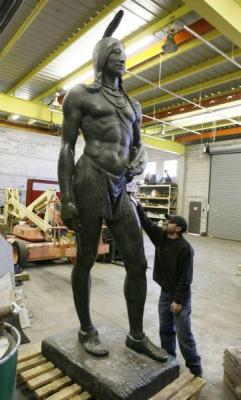In
Quality of After the Mayflower, I critiqued the storytelling aspects of the first episode of PBS's
We Shall Remain series. In
Thanksgiving in After the Mayflower, I began discussing the show's content. Let's continue with this thread.
After the first Thanksgiving, Massasoit formally ceded Patuxet, site of new Plymouth, to the Pilgrims. The settlement was officially theirs from that point on.Edward Winslow, who became the Pilgrims' chief emissary to the Wampanoags, consider them "trustworthy, quick of apprehension, just." So even back then, those who got to know the Indians realized they weren't cruel or vicious savages. Those who didn't get to know them are to blame for many of the misunderstandings.In 1623, Myles Standish heard rumors of the Massachusett Indians threatening to the north. He led a preemptive raid against them and killed some of them. When he returned, he displayed a decapitated head to frighten the Wampanoags.Is this the first case of a preemptive strike by the Euro-Americans? And the first case of domestic terrorism? Could be.
The English mistook wampum for European-style money and initiated a trading system based on it. The Indians supplied beaver pelts and beaver hats became a fashion accessory in Europe.A fleet arrived in 1630 with 1,000 colonists to establish the Massachusetts Bay Colony. These people considered it a God-ordained practice to spread civilization and Christianity. This is when John Winthrop, the future governor, called the new colony a "city on a hill."The English came with sense of entitlement, as if the great space was theirs to occupy and the great resources were theirs for the taking. They established town after town, with smallpox and other diseases doing their dirty work for them. One preacher said something like, "The land was almost cleared of those pernicious creatures so as to make way for a better growth.""Pernicious creatures"...nice. In other words, a representative of the Christian faith considered Indians akin to vermin. It's pretty clear how un-Christian these Christians were.
Massasoit didn't feel any pressure to resist for the first 20 years. But the English population ballooned from 300 to 20,000. The colonists' livestock, particularly the pigs, ran loose and devastated the land. The fur trade depleted the beavers until they were almost gone.By the time Massasoit realized how relentless the English were, they didn't need his help with the other Indians any longer. When Massasoit told them of his pact with the Pilgrims, the more recent colonists shrugged and said "What treaty?" They forced him to cede Wampanoag land piece by piece until little was left.Is this the first treaty broken by Anglo-Americans? Could be.
By the way, my impression of Massasoit is that he also was trustworthy, quick of apprehension, and just--just like Edward Winslow said of the Wampanoags in general. He was a wise leader worth remembering--but not a great man like Tecumseh or Sitting Bull. Therefore, I still say the
stereotypical Massasoit statue in Utah is the wrong way to portray him.
For more on the subject, see
Native Documentaries and News.
Below: Massasoit...demi-god or good leader?



No comments:
Post a Comment